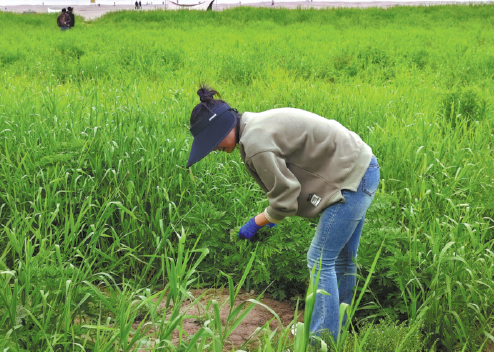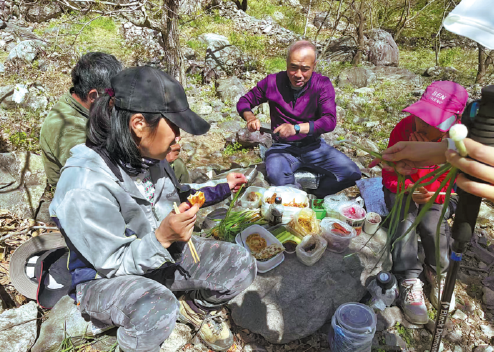Foraging adds natural flavor to fresh dishes
With arrival of spring, Beijingers head to suburbs to gather wild vegetables

Foraging, the act of sourcing food from natural, unspoiled environments, serves as a captivating means of culinary exploration. While no longer a necessity for sustenance in modern times, foraging is a complete food adventure that involves hiking, farming and procuring unique ingredients, and has evolved into a healthy escape for city dwellers seeking respite from the daily hustle and bustle of urban life.
Traditionally embraced by the country's seniors, foraging for wild vegetables has developed into a trend, its popularity propelled by the reach of social media platforms.
The hashtag "foraging wild vegetables" on popular short video platform Xiaohongshu has garnered 200 million views and sparked over 900,000 discussions.
The vibrant community "We All Love Foraging Wild Vegetables" on Douban, a leading Chinese review platform, is buzzing with activity. Members share their bountiful harvests from various corners of the country, featuring delights such as freshly plucked bamboo shoots from Nanjing, Jiangsu province, the delicate curls of young ferns from Guangdong province, and the tender leaves and blossoms of Chinese violet cress from Beijing.
Because winter is long and gloomy and spring is brief and elusive in Beijing, residents of the capital seize every opportunity and find myriad reasons to venture outdoors and explore the city's nature. Among these pursuits, foraging stands out.
On grassy slopes, along verdant banks of rivers, or in open expanses of parks on the outskirts of Beijing, the sight of foragers equipped with putty knives and plastic bags has been a familiar scene.
A taste of spring
"We started our foraging season in mid-March," said a woman surnamed Zhang, who works with a State-owned company in Beijing and chose not to tell China Daily her full name.
Along with her husband and their sixth-grade son, she shares a passion for hiking and often explores the hills on the outskirts during weekends. Zhang keeps an eye out for any signs of plant growth while they are on their hikes.
"In earlier spring, I started searching for jicai (shepherd's purse) in the wildness," she said. "For people from South China like us, it is one of our favorite wild vegetables and also one of the earliest plants to sprout in Beijing. The thought of jicai dumpling soup makes my mouth water."
She said that she and her husband are not real foragers. The primary allure of foraging for them is the opportunity to enjoy seasonal vegetables. "Spring vegetables are fresh and nutritious," Zhang said.
She enjoys serving wild vegetable dishes, which offer a "distinctive taste of spring". The real foragers of the family are her mother and parents-in-law. The three senior members of the family share a hobby — collecting wild vegetables.
On a Saturday in March, the couple drove their parents to "our secret valley" and set the seniors free. The couple foraged for a while and then prepared their lunch at their camp site. "Foraging can be quite demanding, and I tend to tire quickly," Zhang said. "But our parents are truly adept at identifying and collecting wild vegetables. In just one day, they managed to harvest more than 10 kilograms of jicai."
After the outing, the family can enjoy jicai dumpling soup for a few meals, she said.
In early April, shepherd's purse, a flowering plant in the mustard family that grows all over the world and is one of the most common wildflowers on Earth, started flowering. The wild vegetable's leaves grew too ripe and firm to eat. Zhang turned her attention to Chinese violet cress, which is native to northern and southeastern China and the Democratic People's Republic of Korea.
She had never treated it as a wild vegetable until a friend told her that it is actually a healthy vegetable. The family foraged Chinese violet cress during a weekend last month, and didn't have to drive far from downtown Beijing.
"The flowers are everywhere," Zhang said. "We carefully selected tender buds and leaves from the upper parts of the plants along the Wenyu River bank. Following a rainfall, more new leaves and buds will sprout from the plants."
At home, Zhang briefly blanched the wild vegetable in boiling water before stir-frying it for a minute or two and seasoning it with soy sauce. "The flavor is simply delightful, a little reminiscent of tender pea shoots," she said.
Enjoying the process
However, foraging offers more than just culinary benefits. While a few foragers in Beijing view it as a simple form of exercise, others simply relish the act of hunting for different edible plants, finding joy in the search itself.
"The entire process is like doing repeated deep squats," said Shen Xiaohong, a retiree living near the Beijing Capital International Airport. "Your heart rate increases, and if you go in the morning, the sun warms your back. So I consider foraging a proper morning exercise."
She rarely ventures outdoors solely for foraging; instead, she incorporates it as a side activity during her morning walks. And she doesn't consume all of her harvests with her husband; instead, she shares them with friends in her neighborhood.
During weekend visits, her daughter, a young office worker, accompanies her mother on these walks and sometimes forages alongside Shen.
She can have a break from the constant pressure of work and digital distractions, Shen said. "While foraging, she doesn't have to check her phone or work messages for hours," the mother said.
Wu Feng, a 40-year-old office worker in Beijing, started foraging in the spring of 2021 during the COVID-19 pandemic. Because of travel restrictions, the outdoor enthusiast spent a lot of his spare time exploring the wilderness in Beijing.
While visiting Baihua Mountain scenic area, he met local women foraging in the forests, "collecting a kind of big tender leaf similar to lettuce".
"They told me it can be eaten with barbecue beef," Wu said.
At Yudushan Mountain in Beijing's Yanqing district, he met a ranger who picked young leaves of a wild pea flower on his regular patrol around the scenic area. "It would add a dish to his lunch," Wu said.
Wu was intrigued by foraging. Lacking any knowledge of edible wild vegetables, however, he didn't try.
Then one day, he visited a valley with his son and Lin Shu, the family's nanny. They stumbled upon a patch of pine forest. Lin, a 55-year-old rural woman who hailed from Hebei province and had migrated to Beijing for work, identified a type of "wild green onion", an edible vegetable she used to forage back in her hometown.
"She gathered a bag of the wild vegetable, stir-fried it with minced meat and mixed the meat sauce with noodles," Wu said. "It was a memorable culinary delight."
Lin is quite knowledgeable about wild vegetables in North China and has taken on the role of teaching her employer about these edible plants.
Wu has learned how to recognize a variety of common wild vegetables in Beijing, knowing that the wild onion is actually Longstamen onion bulb, or Chinese garlic, the leaves the women foraged on Baihua Mountains are a species of chrysanthemum distributed in forests in North China, and the wild pea flower from Yudushan Mountain is two-leaf vetch.
While on outings, he selectively forages, waiting for the right moment to gather wild vegetables. "I am quite picky when it comes to wild vegetables," he said. "I only choose those that grow in clean environments, ensuring they are fresh with the most tender leaves."
He usually forages each species of wild vegetable only once in a season. "The plants grow truly fast in the spring," he explained. "In a week, they become fresh and tender and one or two weeks later, they mature and firm up. So after gathering a portion for a taste, I will leave them alone."
He said that the slow, methodical nature of foraging allows him to immerse himself in nature. "Distinguishing wild vegetables from weeds requires keen observation," Wu said. "There are moments of surprise and reward. It's a process I truly enjoy."
Safety concern
Along with a rise in the number of foragers, Wu said he found that certain species of wild vegetables have grown scarce in their natural habitat. "Last year I found very little Chinese garlic at the site I foraged in 2021," he said. "I didn't gather any."
He said that he has never foraged in parks or scenic areas such as Yudushan Mountains or Baihua Mountains, nor has he gathered any unfamiliar species. "So many plants look just too similar," Wu said. "It's crucial to be cautious about the safety of foraged plants."
His opinion was echoed by Luo Chunyu, a manager at City Lvxin Forest Park in Beijing's Tongzhou district.
He warns against foraging in parks.
"These plants are part of the landscape and help prevent soil erosion. Foraging can damage the greenery and lead to bare patches," he told Beijing Traffic Radio recently. "Also we use pesticides for pest control, which can be harmful if ingested."
To ensure safety, Shi Jun, a botanist from the Chinese Academy of Sciences, advises caution. He told Beijing Traffic Radio that many wild plants carry toxins.
"If you taste something bitter or numbing, it's likely toxic. Stop eating immediately and seek medical attention with a sample of the plant," he said.
Shi also emphasizes the wisdom of our ancestors, who spent millennia identifying safe, nutritious plants to cultivate. "Our ancestors spent 8,000 years domesticating safe, nutritious crops," he said. "Why gamble on wild greens when markets sell guaranteed-safe veggies?"
Wu said that a modern forager should be environmentally sensitive. "Anyway, foraging is not about the food. It's about slowing down, touching soil and knowing the plants living near you."




Today's Top News
- China, US hold maritime safety talks in Hawaii as Beijing reiterates warnings on sovereignty
- China sends letter to UN over Japanese PM's remarks on Taiwan
- Chinese, Uzbek FMs hold second strategic dialogue
- G20 an opportunity to strengthen Sino-EU ties
- China, Africa foster shared food security
- Japan urged to take practical steps to honor its commitments to China






























